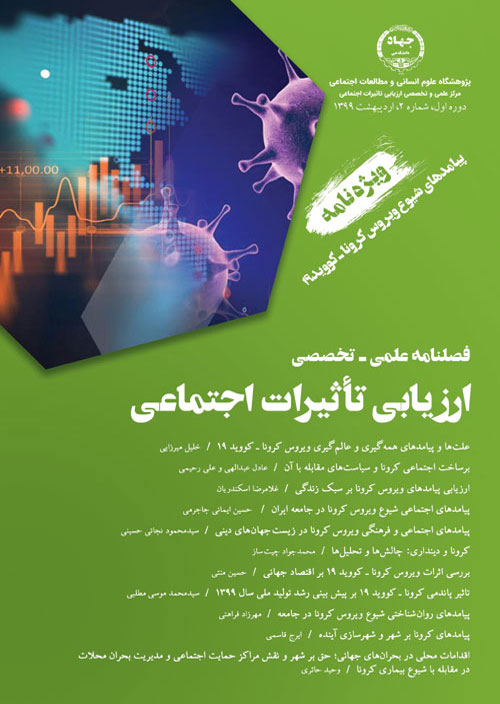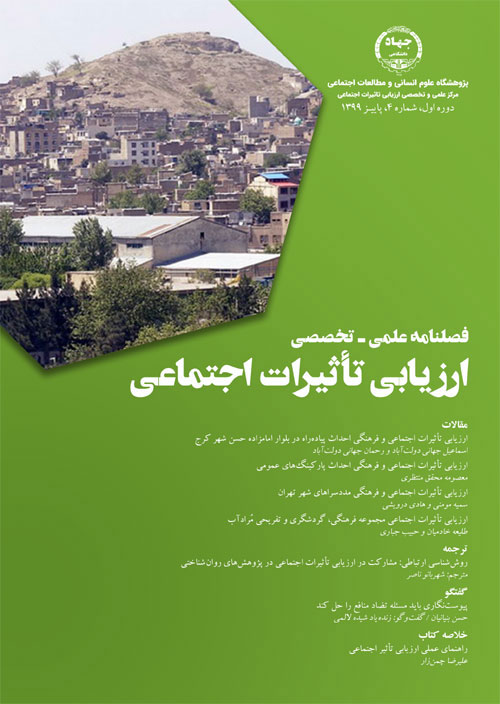فهرست مطالب

نشریه ارزیابی تاثیرات اجتماعی
پیاپی 3 (تابستان 1399)
- تاریخ انتشار: 1399/08/08
- تعداد عناوین: 8
-
صفحات 7-9
-
صفحات 13-33
مدیریت شهری منطقه 12 شهرداری تهران برای فضای 2012 مترمربعی در محله دروازه شمیران، ساخت بوستان، میدان میوه و ترهبار و فودکورت را به عنوان سه گزینه پیشنهادی مدنظر دارد. این مقاله میکوشد ضمن نیازسنجی از ساکنان محله، امکانسنجی ساخت هر یک از پروژه ها را از حیث پیامدهای اجتماعی و فرهنگی بررسی نماید. برای نیل به این مقصود با توجه به جمعیت 33297 نفری محله و استفاده از فرمول کوکران، پیمایشی در میان 387 نفر انجام گرفت و با 11 نفر از مدیران محلی و منطقهای مصاحبه انجام گرفت. برای نیازسنجی و امکانسنجی پروژه ها از چارچوب نظری توسعه پایدار شهری با تکیه بر مفهوم حوزه عمومی استفاده شد. پس از بررسی، این نتیجه به دست آمد که با توجه به اهمیت حوزه عمومی و نیاز مبرم محله دروازه شمیران به آن، ساخت بوستان در مکان مدنظر باید نسبت به دو گزینه دیگر یعنی میدان میوه و ترهبار و فودکورت در اولویت قرار گیرد. نتیجه دیگر اینکه با توجه به تقسیمبندی تهران به محات مختلف و سیاست محله محوری در مدیریت شهری تهران، در اختیار قرار دادن خدمات شهری بر مبنای محله است، در حالی که به نظر میرسد معیار »محله محوری« در ارایه خدمات شهری باید به معیار »فاصله« و »جمعیت« تغییر داده شود. در پایان، برای استفاده بهتر از بوستان و در راستای تعریف آن به عنوان حوزه عمومی، پیشنهادهایی چون احداث موزه تاریخی در محل بوستان و احیای آسیاب والی واقع در محله ارایه شده است.
کلیدواژگان: توسعه پایدار شهری، حوزه عمومی، بوستان، ارزیابی تاثیراتاجتماعی اتا و محله دروازه شمیران -
صفحات 35-56
پروژه احداث بوستان گالبدره با هدف پاسخگویی به نیازهای ساکنان منطقه 1 شهرداری تهران و سایر ساکنان شهر تهران اجرا شده است. به طور کلی اهداف انجام پژوهش حاضر شامل: شناسایی ذینفعان بازندگان و برندگان و ذیمدخالن پروژه، بررسی تاثیرات اجتماعی و فرهنگی ناشی از اجرای پروژه در حوزه نفوذ پروژه، شناسایی موانع و مشکالت اجتماعی نهادی و اجتماعی پروژه و ارایه راهکارهایی برای بهبود و اصالح وضع موجود و کاهش اختال در زندگی شهروندان، تعیین حوزه نفوذ پروژه و شناخت نگرش شهروندان نسبت به این پروژه است. نوع مطالعه در این پژوهش از نظر مسیر، توصیفی و از نظر هدف، کاربردی بوده است. برای گردآوری اطالعات نیز از روش های میدانی و اسنادی استفاده شده است. البته باید اشاره کرد که پژوهش حاضر را میتوان در شمار پژوهشهایی قرار داد که با عنوان ارزیابی مطرح شده اند. در بخش اسنادی، کلیه اسناد موجود تمام شماری شده و در بخش میدانی نیز 300 نفر از ساکنان و مراجعان به بوستان گالبدره به عنوان نمونه انتخاب و پرسشنامه مدنظر روی آنها اجرا شده است. در عین حال با مدیران شهرداری و عوامل اجرایی و نهادهای ذیربط نیز به صورت هدفمند و در دسترس مصاحبه نیمه ساختدار انجام شده است. ابزار به کار رفته در این پژوهش، فیشهای اطالعاتی، پرسشنامه پژوهشگرساخته - که اعتبار آن از طریق اعتبار محتوا ضریب CVR و پایایی آن از طریق آلفای کرونباخ سنجیده شده است-، مصاحبه نیمه ساختدار و مشاهده بوده است. این مطالعه نشان میدهد که ساخت این بوستان دارای پیامدهای مثبت و منفی بوده است که پیامدهای مثبت آن بر پیامدهای منفی غلبه داشته است. از جمله پیامدهای مثبت احداث بوستان گالبدره، جلوگیری از ساختوسازهای غیر مجاز و زمینخواری، ایجاد کمربند سبز در دامنه کوه البرز، تغییر در الگوی رفتار خانواده، زیبایی محیط، کاهش آلودگی هوا و آلودگی صوتی، افزایش احساس سامتی و تعامات اجتماعی در افراد، ایجاد فرصتهای شغلی و از پیامدهای منفی، افزایش ترافیک و کمبود جای پارک است
کلیدواژگان: تاثیرات اجتماعی، تاثیرات فرهنگی و بوستان گالبدره -
صفحات 57-99
این مقاله، مروری است بر گزارشهای ارزیابی تاثیرات اجتماعی تدوینشده در شهرداری تهران، با این هدف که بر یکی از متغیرهای موثر بر ایجاد شرایط فعلی این حوزه مطالعاتی تمرکز و تاش گردد تا با مرور نظام مند این گزارشها و بیان برخی از ویژگیهای مثبت و منفی آنها، به ارتقای کیفی این حوزه مطالعاتی کمک گردد. بنابراین با رویکردی کیفی و استفاده از مرور نظام مند و نگاهی ژرفانگر تاش شده است تا از میان 89 گزارش منتخب که پس از چند مرحله غربالگری انتخاب شده اند، ویژگیهای مختلف ساختاری، صوری و محتوایی این گزارشها بررسی و برخی از مشکالت موجود در آنها بیان گردد. به این منظور، نخست پروتکلی تدوین و بر اساس آن ابزاری طراحی و اطالعات مورد نیاز از گزارشها استخراج و وارد نرم افزار شده و خروجیهایی توصیفی از آن گرفته شد و تاش گردید تا با مقایسه هایی بین شاخصهای طراحیشده برای سنجش هر متغیر، تصویری کلی از این گزارشها ارایه گردد.
کلیدواژگان: مرور نظاممند، ارزیابی تاثیرات اجتماعی و فرهنگی اتاف وشهرداری تهران -
صفحات 103-130
مقاله حاضر به بازنگری ادبیات و عملکرد ارزیابی تاثیر اجتماعی (اتا) برای پاسخ به برخی از پرسشهای همیشگی میپردازد که همه شاخههای ارزیابی تاثیرات با آن مواجه بودهاند. پرسشهایی همچون: چه قلمرویی برای گسترش ارزیابی تاثیر فراتر از پروژهها میتواند وجود داشته باشد؟ چگونه شاخههای مختلف ارزیابی تاثیر با یکدیگر ارتباط پیدا میکنند و در هم ادغام میشوند؟ رابطه بین ارزیابی علمی و مشارکت عمومی چیست؟ این مطلب را به بحث میکشد که به حاشیه رانده شدن نسبی اتا (ارزیابی تاثیرات اجتماعی)، باعث محدود شدن اثربخشی و تاثیرگذاری همهجانبه ارزیابی تاثیر شده است. با این حال در این موضوع (به حاشیه رانده شدن ارزیابی تاثیر اجتماعی) نمیتوان جهانبینیهای فنسالار و مقاصد سیاسی حامیان پروژه، دولتها و سازمانهای علمی را کاملا مقصر دانست و سرزنش نمود. ناکامی در حل و فصل تناقضات اساسی نظری مرتبط با اهداف و روشهای ارزیابی تاثیر، بهویژه نقش بحثبرانگیز پیشبینی در اتا، از قدرت آن کاسته است. هرچند ممکن است این مشکلات فرجامی پیدا نکنند، اذعان به آنها و شفافسازی آنها به پیشرفت ارزیابی تاثیر منجر میشود.
کلیدواژگان: ارزیابی تاثیرات اجتماعی و ارزیابی پروژه -
صفحات 131-183
علیرغم اهمیت تاثیر اجتماعی در تحقیقات کارآفرینی اجتماعی، استانداردهای سنجش تاثیر اجتماعی یک سازمان، هم از لحاظ نظری و هم از لحاظ تجربی توسعه نیافته هستند. ما نمونهای با حجم 71 مقاله مرتبط از مجات پیشرو در حوزه کسب وکار FT50 را شناسایی کردیم که به طور مفهومی یا تجربی، سنجش تاثیر اجتماعی را بررسی کرده اند. ما ابتدا وسعت تعاریف، منابع داده و عملیاتیسازی تاثیرات اجتماعی را توصیف کردیم. بر اساس این تحلیل، ما یک گونه شناسی چهار رویکردی از مفهوم سازی تاثیر اجتماعی تولید نمودیم که از آن برای سازماندهی بینشها و پیشنهادهای مربوط به سنجش بهبودیافته تاثیر اجتماعی سرمایه گذاریهای کارآفرینانه استفاده کرده ایم.
کلیدواژگان: کارآفرینی اجتماعی، تاثیر اجتماعی، ارزش اجتماعی، عملکرداجتماعی و سنجش عملکرد -
ارزیابی تاثیرات اجتماعی باید صدای مردم باشد / گفتگو با»حسین ایمانی جاجرمی«دانشیار گروه مطالعات توسعه اجتماعی دانشگاه تهرانصفحات 187-200
-
صفحات 203-230
-
Pages 13-33
The city management of the 12th district of Tehran’s municipality plans to build a boostan, fruit and vegetable field and Food- court as the three suggested options for the 2012 square-meter space in the Darvazeh Shemiran neighborhood. This article tries to assess the feasibility of building each project in terms of social and cultural outcomes, while assessing the needs of the residents of the neighborhood. To reach this goal, a survey of 387 people was conducted and an interview has been conducted with 11 local and regional directors, according to the population of 33297 residents using the Cochran formula. For the Need evaluation and feasibility evaluation of the projects, the theoretical framework of sustainable urban development was used based on the concept of the public sphere. After review, the result was that considering the importance of the public sphere and the urgent need of the Darvazeh Shemiran neighborhood, the construction of the boostan at the intended place should be prioritized to the other two options, the fruit field and the Food court. The other result is that considering the division of Tehran into different neighborhoods and the policy of the central neighborhood in Tehran’s urban management, providing urban services is based on the neighborhood while it seems that the “neighborhood” criterion for providing urban services should be changed to the “distance” and “population” criteria. In the end, for better use of the boostan and its definition as a public sphere, suggestions such as the construction of a historic museum in the place of Boostan and the revitalization of the Vali mill in the neighborhood have been presented.
Keywords: Assessment of social, cultural impacts, Darvazeh Shemiran neighborhood, Boostan, Public Sphere, Sustainable Urban Development -
Pages 35-56
This research was conducted to assess the socio-cultural impacts of Golabdarreh Park in Region 1 of Tehran Municipality and mainly has aimed to identify stakeholders and obstacles of the project. It also provided solutions to improve the status quo and decrease citizens’ social problems. This research was descriptive from the viewpoint of procedure and applied from the viewpoint of objective, and the data were collected through documentary and field method. In the documentary section, all of the presented documents were reviewed and in the field section, 300 residents were chosen as a sample and the questionnaire was administered on them. At the same time, the municipal managers, the operational officials and the concerned institutions were interviewed by semistructured interview procedure with purposive and convenience sampling. The findings showed that the construction of the park had both positive and negative impacts, but the positive ones outweighed the negative ones. The most important positive impacts included restraining from illegal constructions and land-grabbing, generating a green belt in Alborz mountain range, changing the families’ behavior patterns, increasing environmental aesthetics, decreasing noises and air pollution, increasing health and social interactions, and creating job opportunities.
Keywords: Social Impacts, Cultural Impacts, Golabdarreh Park -
Pages 57-99
The present paper aims to review the social impact assessment reports conducted by Tehran Municipality and to specify their pros and cons with a focus on the variables affecting the current conditions of this field of research. With that end in view, after several stages of screening 89 reports was selected and systematically reviewed with a qualitative approach and an in-depth perspective in order to study their various structural, formal and content specifications and to identify available faults. Therefore the first step was to develop a protocol and design an instrument to extract needed information from the reports. In the next step, descriptive outputs were taken from the software to give the designed indicators comparability, and in the end an overall image of these reports was provided.
Keywords: Systematic Review, Social Impact Assessment (SIA), Tehran Municipality -
Pages 103-130
This article reviews the literature and practice of social impact assessment (SIA) to address some of the perennial questions faced by all fields of impact assessment. What scope is there to extend impact assessment beyond individual projects? How might the different branches fit together? What is the relationship between scientific assessments and public participation? It argues that the relative marginalization of SIA has limited the effectiveness and influence of all aspects of impact assessment. However, this marginalization cannot be blamed entirely on the technocratic world views and political agendas of project proponents, governments and scientific agencies. The strength of SIA is undermined also by a failure to resolve fundamental theoretical contradictions concerning the objects and methods of impact assessment, in particular, the contested role of prediction in SIA. While closure on these issues may not be possible, acknowledgement and clarification of them does suggest positive routes forward for impact assessment.
Keywords: social impact assessment, project appraisal -
Pages 131-183
Despite the importance of social impact to social entrepreneurship research, standards for measuring an organization’s social impact are underdeveloped on both theoretical and empirical grounds. We identify a sample of 71 relevant papers from leading (FT50) business journals that examine, conceptually or empirically, the measurement of social impact. We first describe the breadth of definitions, data sources, and operationalizations of social impact. Based on this analysis, we generate a typology of four approaches to conceptualizing social impact, which we use to organize insights and recommendations regarding improved measurement of the social impact of entrepreneurial ventures.
Keywords: social entrepreneurship, social impact, social value, social performance, performance measurement


